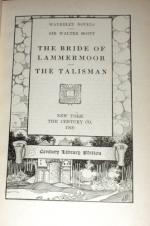There was about this time, in the village of Langdirdum, a peripatetic brother of the brush, who exercised his vocation sub Jove frigido, the object of admiration of all the boys of the village, but especially to Dick Tinto. The age had not yet adopted, amongst other unworthy retrenchments, that illiberal measure of economy which, supplying by written characters the lack of symbolical representation, closes one open and easily accessible avenue of instruction and emolument against the students of the fine arts. It was not yet permitted to write upon the plastered doorway of an alehouse, or the suspended sign of an inn, “The Old Magpie,” or “The Saracen’s Head,” substituting that cold description for the lively effigies of the plumed chatterer, or the turban’d frown of the terrific soldan. That early and more simple age considered alike the necessities of all ranks, and depicted the symbols of good cheer so as to be obvious to all capacities; well judging that a man who could not read a syllable might nevertheless love a pot of good ale as well as his better-educated neighbours, or even as the parson himself. Acting upon this liberal principle, publicans as yet hung forth the painted emblems of their calling, and sign-painters, if they seldom feasted, did not at least absolutely starve.
To a worthy of this decayed profession, as we have already intimated, Dick Tinto became an assistant; and thus, as is not unusual among heaven-born geniuses in this department of the fine arts, began to paint before he had any notion of drawing.
His talent for observing nature soon induced him to rectify the errors, and soar above the instructions, of his teacher. He particularly shone in painting horses, that being a favourite sign in the Scottish villages; and, in tracing his progress, it is beautiful to observe how by degrees he learned to shorten the backs and prolong the legs of these noble animals, until they came to look less like crocodiles, and




